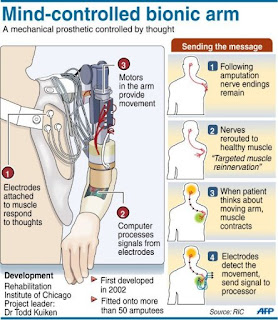Reality overcomes fiction once more. Some years ago, a bionic arm was something we could only imagine in the Terminator or Star Wars movies. Remember the mechanical hand that Luke Skywalker had implanted after Darth Vader cut his hand with his lightsaber? Well, nowadays thousands of people with amputees arms already benefit from a similar technology.
Initially patients could move the arm through redirected nerves that sent electrical signals to sensors placed on his chest. The first prototype was implanted to the American Jesse Sullivan in 2002. Jesse is an electrician and suffered a terrible accident in May 2001 as he touched a wire with a voltage close to 7,500 volts. The bionic arm that he had implanted cost around six million dollars. The second person who received one of these prostheses was the young Claudia Mitchell (27 years). The former Marine lost his left arm in a motorcycle accident and has been operating with its robotic limb since August 2006. Claudia can now put on shoes, wash or peel a banana. Furthermore, she had the sense of touch restored as she was able to feel things she touched with her artificial hand through a device attached to her chest. During a four-hour operation, surgeons moved nerves from her shoulder, which normally ferry signals from the hand to the brain, and redirected them to muscles in her chest area. Four months after surgery, a patch of skin on her chest was able to feel touch, temperature and pain sensations as if they were coming from different parts of her hand and wrist.
Last year, Dr. Todd Kuiken, director of bionic medicine center and director of amputees at the Rehabilitation Institute of Chicago (RIC) presented a new advancement, the Targeted Muscle Reinnervation (TMR). Kuiken and his team developed this innovative surgical procedure that routes signals from the brain to the nerves of the muscles that are healthy after an amputation, allowing patients to control their prosthesis just by thinking the action they want to perform. This was the world's first bionic arm controlled by nerves, which reflects the patient's brain impulses. (See image to learn a bit of how it works)
If you want to know more about bionic arms, I recommend you the Bionic Bodies series on the BBC News website: http://www.bbc.co.uk/news/health-17139965
Also, check out this video if you want to see how a young orthopaedic patient is getting used to a new bionic arm:
See you soon
